SICB Annual Meeting 2012
January 3-7, 2012
Charleston, SC
Symposium: Mangrove ‘Killifish’: an Exemplar of Integrative Biology
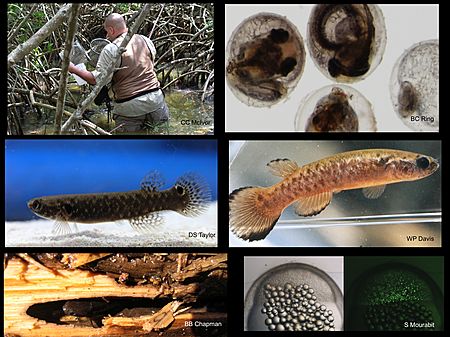
Photo captions left to right, top to bottom: Dr. Earley checking traps in the mangroves; embryos from mutagenesis screen; adult hermaphrodite; adult male; terrestrial hermaphrodite in mangrove log; and mid-gastrula stage/yolk syncytium formation (light microscopy on left, sytox green injected fluorescent image on right).
Summary: While there is genetic evidence of a second putative self-fertilizing hermaphrodite species, the mangrove killifish (rivulus) remains the only recognized self-fertilizing hermaphroditic vertebrate. In the wild, hermaphrodites predominate and males, although present in some populations, are rare. In the lab, individual adult rivulus propagated separately can produce isogenic embryos. Under certain conditions, males develop and outcrossing between the hermaphrodites and males has been confirmed through genetic analysis. Rivulus were also the first fish species found to have environmental sex determination, where lower temperatures inhibit ovarian development, thus providing at least one potential route to avoiding inbreeding depression. Imagine the behavioral, neurological, and endocrinological control necessary to accommodate this reproductive strategy!

Frontal section of hermaphrodite bilobed ovotestis (left) with testicular tissue (T) between ovarian tissue (O) and swimbladder (SB). Frontal section of male bilobed gonad (right). Photos by Dr. Edward Orlando.
Rivulus also have a fascinating ecology where they are one of only a few fishes that spend their entire life cycle in the mangrove ecosystems. They reside in crab burrows in the mangrove substrate and have adaptations that enable them to survive in relatively poor water conditions. As such, rivulus are sentinel species of potential effects of exposure to environmental stressors for other organisms living in the mangroves. When pushed beyond physiological limits, rivulus may estivate, collect in rotting mangrove logs, or, alternatively, emerge from the water and move across mud flats making use of cutaneous respiration.
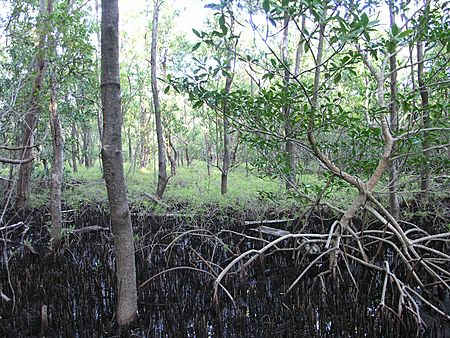
Rivulus habitat in the mangroves of Belize (photo by Dr. Scott Taylor)
Goals of the Symposium: This symposium will drive future research within our group and facilitate networking between lab heads and current – and potential future – post-docs and students. Given the breadth of our speakers’ research, we hope that our symposium will be popular and well attended. We expect to entice some of these attendees to bring rivulus into their labs. This diminutive fish is emerging as a powerful model for integrative biological research spanning ecology, evolution of phenotypic plasticity and life history traits, behavior, endocrinology, genetics, and genomics. In part, this emergence will be catalyzed by this first mangrove rivulus symposium.
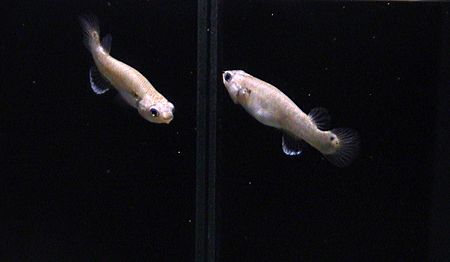
Aggressive behavior in hermaphrodite vs. hermaphrodite separated by a partition (photo by Jing-Huan Kuo, Dr. Yuying Hsu’s lab).
Sponsors:
-
NIH, Eunice Kennedy Shriver National Institute of Child Health & Human Development
![]()
- SICB Divisions: Animal Behavior, Comparative Endocrinology, Comparative Physiology and Biochemistry,
- SICB C. Ladd Prosser Symposium Fund
- University of Maryland, College of Agriculture and Natural Resources
![]()
-
University of Alabama, Biology Department, Tuscaloosa, AL
![]()
-
Valdosta State University, Biology Department, Valdosta, GA

Organizers:
-
Edward F. Orlando, University of Maryland, Animal & Avian Sciences Department, College Park, MD
-
Ryan L. Earley, University of Alabama, Biological Sciences Department, Tuscaloosa, AL
-
Brian C. Ring, Valdosta State University, Biology Department, Valdosta, GA,
-
David L. Bechler, Valdosta State University, Biology Department, Valdosta, GA
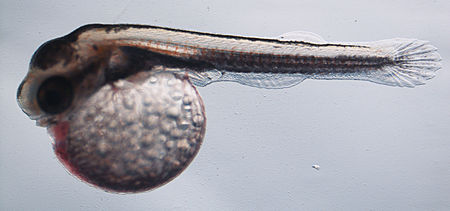
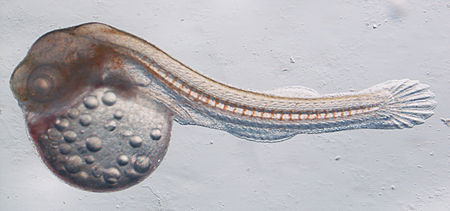
Wild type (left) and melanin synthesis inhibited (right, PTU treated) late stage embryos (photos by S. Mourabit, Dr. Tetsuhiro Kudoh’s lab)
Speakers
S2-1.0 Wednesday, Jan. 4, 07:45 Orlando, E.F., and a Special Guest:
Introduction
S2-1.1 Wednesday, Jan. 4, 08:00 TAYLOR, D. Scott:
Twenty-four years in the mud: what have we learned about the natural history and ecology of Kryptolebias marmoratus?
S2-1.2 Wednesday, Jan. 4, 08:30 KELLEY, JL*; YEE, MC; LEE, C; LEVANDOWSKY, E; SHAH, M; HARKINS, T; EARLEY, RL:
Bringing genomics to non-model organisms: the promise of de novo genome assembly and population genetics of the fish Kryptolebias marmoratus
S2-1.3 Wednesday, Jan. 4, 09:00 TATARENKOV, A.:
Population genetics and phylogeography of a selfing killifish, Kryptolebias marmoratus
S2-1.4 Wednesday, Jan. 4, 09:30 BIELMYER, GK*; DECARLO, C; MORRIS, C; CARRIGAN, T; BULLINGTON, JB:
The Influence of Salinity on Zinc and Nickel Toxicity to Two Euryhaline Fish Species
S2-1.5 Wednesday, Jan. 4, 10:30 KUDOH, Tetsuhiro:
The hermaphroditic mangrove killifish as a model for embryological studies
S2-1.6 Wednesday, Jan. 4, 11:00 FARMER, J.L.; ORLANDO, E.F.*:
Effects of Developmental Exposure to Ethinyl-Estradiol on Gene Expression and Fitness of the Adult Rivulus, Kryptolebias marmoratus
S2-1.7 Wednesday, Jan. 4, 11:30 SUCAR, S.; NEWSOME, J.M.; MOORE, G.L.; RING, B.C.*:
Establishing Developmental Genetics in the Mangrove Killifish (Kryptolebias marmoratus)
S2-2.1 Wednesday, Jan. 4, 13:00 WRIGHT, Patricia A:
Environmental Physiology
S2-2.2 Wednesday, Jan. 4, 13:30 HSU, Yuying*; CHANG, Ching:
The relationship between aggressiveness and boldness, tendency to explore and learning performance in Kryptolebias marmoratus: the influence of recent contest experiences and the roles of hormones
S2-2.3 Wednesday, Jan. 4, 14:00 EARLEY, Ryan L.*; HANNINEN, Amanda F; FULLER, Adam; GARCIA, Mark J; STANLEY, Shane; LEE, Elizabeth A; TAYLOR, D. Scott:
Plasticity, integration, and selection: prospects for exploring the evolution of complex phenotypes in a powerful fish model
S2-2.4 Wednesday, Jan. 4, 14:30 BECHLER, D.L.:
Kryptolebias marmoratus, the mangrove rivulus, as a model organism for comparative research

